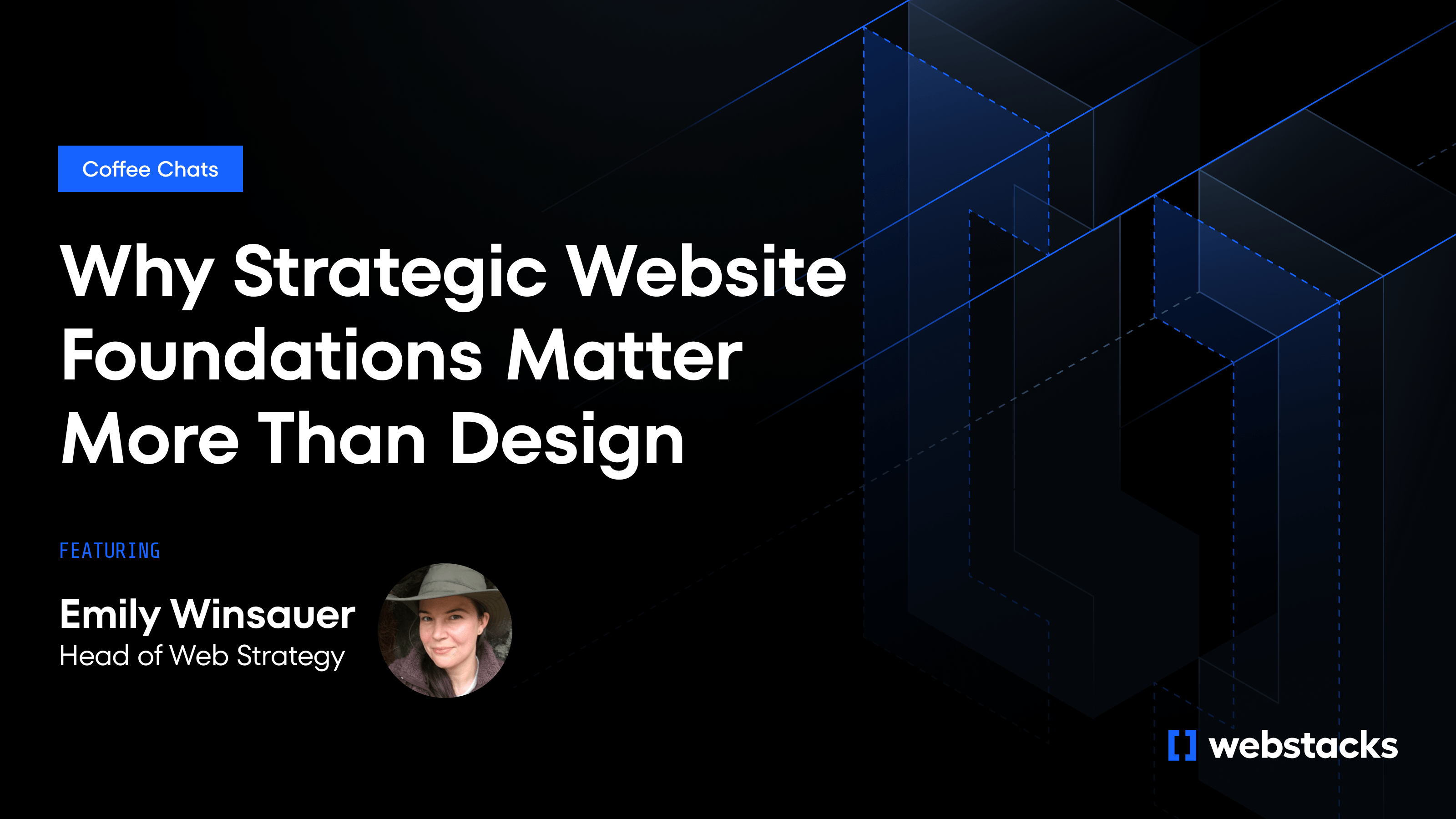Most B2B companies overspend on design and underinvest in the strategic planning that makes websites scalable.
"Our job is not to dictate what needs to happen at every stage. Our job is to contribute what we can and then leave space for the other extremely talented people on the team to contribute what they can."
That's Emily Winsauer, Lead Strategist at Webstacks, describing the collaborative philosophy behind every website project her team executes. In a recent conversation I had with Emily and Jesse Schor, Head of Growth, Emily explained what web strategy actually means in practice and why it's the most critical (and most overlooked) phase of any website redesign or migration.
For B2B SaaS leaders managing rapid growth, websites function as growth infrastructure. Most companies still treat them as branding deliverables rather than revenue engines. Emily's approach reveals how strategic discovery, stakeholder alignment and long-term planning transform websites from one-time builds into scalable systems.
Strategic Foundations Start With Pre-Sale Technical Discovery
Most agencies start strategic planning after a contract is signed. Webstacks starts before the first demo call.
After an initial vetting conversation, strategists run a technical crawl of the prospect's site, organize a content inventory and build preliminary scope options. That same spreadsheet becomes the primary planning document for the entire engagement.
"We need to sell based on both a business understanding and a technical understanding of the client's website and their needs," Emily said. By the time a contract is signed, the team already understands the site's footprint, existing pain points and structural opportunities.
Understanding What Currently Exists
This pre-sale discovery eliminates scope guesswork. The strategist reviews the existing site structure, content organization, technical health and performance issues. That audit reveals what's working, what's broken and what's missing.
Scope is built around what currently exists, what the client has identified as broken and what the strategist observes as critical gaps. For example, if a client mentions that valuable content is buried and underperforming, the scope includes building a resource hub with better filtering and navigation. If case studies live scattered across the blog, the plan includes a dedicated, searchable case study section.
The Content Inventory Becomes the Project Foundation
The content inventory spreadsheet created during this phase tracks every page URL, content type, traffic data and migration status. It becomes the single source of truth throughout the project. Design references it to understand content volume and types. Development uses it to plan redirects. The client uses it to make pruning decisions.
Clients aren't sold a generic package. They're sold a solution tailored to their actual site, their stated goals and their technical constraints.
Stakeholder Interviews Extract Unique Departmental Perspectives
Stakeholder interviews are the foundation of every successful project. The goal is extracting insights only certain roles can provide.
Emily's team structures interviews around unique perspectives. CEOs discuss competitive positioning, existential threats and long-term business direction. Product leaders explain where users struggle to understand feature integration. Sales teams reveal workflow friction: scattered PDFs they email to prospects because the website lacks usable content. Marketing leaders articulate growth targets, content production plans and audience segmentation needs.
"The goal of the stakeholder interviews is to make sure that we have the information we need so that the choices we're making throughout the project process align with both the company's business goals and how they function," Emily explained.
Tailoring Questions to Each Role
The questions vary by role. A CEO might be asked about existential threats in their space, how the industry has evolved over 10 years and where the company sits against competitors. A product leader might discuss feature comprehension issues or gaps in how users understand the platform. A sales leader might reveal that reps avoid sending prospects to the site because it looks outdated or that critical content is impossible to find.
How Stakeholder Input Shapes Architecture
Emily shared an example from Prismatic, where CEO interviews revealed the company had survived an industry consolidation that killed off many smaller competitors. They were now fighting a few direct rivals and several enterprise incumbents. That context directly influenced information architecture decisions, including building an aggressive competitor comparison section to differentiate against specific players targeting them in ads.
Stakeholder input becomes the raw material for the synthesis work that follows.
Strategy Synthesizes Competing Priorities Into Unified Architecture Decisions
Internal teams naturally advocate for different priorities. Product wants feature education. Sales wants lead capture tools. Leadership focuses on brand positioning. Marketing wants content velocity. Operations wants governance.
Emily's role is to synthesize that input and recommend a path forward that balances competing needs without stalling progress.
"We hear it all from all of them and then say here's how we recommend moving forward to balance those different needs and interests in the context of current best practices," she said.
This synthesis is where strategy becomes tangible. Raw stakeholder input transforms into actual deliverables: site maps, page wireframes, content models, navigation structures and component specifications.
Connecting Dots Across Departments
I've seen one common synthesis challenge: connecting dots across departments that don't realize they're describing related problems. A sales leader might complain that reps avoid sending prospects to the site because it looks outdated. A marketer might mention wanting better case study organization and filtering. A strategist hearing both can propose a solution that solves for both teams: a searchable, filterable client story section with clean design that sales can confidently share.
Balancing Data-Driven and Creative Perspectives
This synthesis is especially valuable when stakeholders have strong, data-driven opinions that conflict. Emily described working with Gong, where the SEO lead resisted any changes not backed by performance data while the creative director wanted to introduce new branded terminology. The strategist's job was to propose a test, a phased rollout or a compromise that respected each viewpoint while keeping the project moving.
I've observed that external perspective matters most here. Internal teams are rightfully invested in their specific priorities. An external strategist can advocate for balance without political baggage. "It is our job to synthesize and balance all of that input, which is something that people tend to really struggle to do internally because they are all rightly very invested in their piece of it," Emily said.
From Input to Deliverables
The synthesis process also produces the primary strategy deliverables that guide design and development. Site maps show the full information architecture and how pages relate to each other. Wireframes communicate content structure and hierarchy without dictating visual design. Menu diagrams clarify navigation logic and user pathways. Content models define fields, relationships and governance rules for the CMS.
Emily emphasized that these deliverables leave room for collaboration. "At the beginning, we were concerned like, is this going to seem like we're telling them it has to be this, but we've gotten into a really great working relationship with pretty much the entire design team so they know if they think they have a better way to do it great."
The result is a plan that serves the business holistically rather than amplifying the loudest voice in the room.
Strategic Foundations Plan for Current Needs and Future Scale
Building a strategic website foundation means solving for today's problems while anticipating tomorrow's growth.
Emily uses a direct metaphor to explain why this matters: "There are a lot of beautiful buildings that aren't fit to purpose. Sydney Opera House is gorgeous. You cannot play a game of baseball in there."
A website that looks modern but doesn't align with business goals or user needs is functionally useless. A website that solves today's problems but can't accommodate next year's growth becomes technical debt within months.
This is why strategists focus on understanding both stated goals and observed gaps. When a marketing team plans to scale educational content rapidly, the site needs flexible templates, an intuitive CMS and a resource hub that supports volume without sacrificing discoverability. When a sales team is emailing PDFs because they can't find content on the site, the solution isn't just better design. It's better information architecture, clearer navigation and multipurpose content that serves both prospects and internal teams.
Jesse reinforced this point: "Don't spend half a million dollars on a website that's not going to perform for you."
Planning for scale manifests in several concrete ways during foundation building.
Building Architecture That Accommodates Expansion
First, the content architecture accommodates expansion. The resource hub is designed with filtering, tagging and search capabilities that work with 50 pieces of content today and 500 pieces next year. Templates are built to support volume without requiring ongoing developer intervention.
Planning Measurement Infrastructure Before Launch
Second, strategists plan for baseline measurement and optimization infrastructure before launch. Emily noted that many clients want to launch A/B testing immediately post-launch, but the site needs time to establish performance benchmarks first. Search engines need to re-index. Traffic patterns need to stabilize. A strong strategic foundation anticipates this timeline and builds the tracking systems that enable measurement from day one. Component-level tracking allows teams to understand which elements drive conversions. Proper event tracking connects website behavior to pipeline outcomes.
"Don't spend six months creating a plan that's going to take a year and a half to execute because by then things are going to have changed. Let's have a goal sketched out and supporting pillars, but you've got to build in room to iterate," Emily said.
Addressing Capacity Constraints Proactively
Third, the foundation addresses capacity constraints proactively. The biggest post-launch blocker Emily hears is writing capacity. Companies know they need to refresh content or expand into new topic areas but lack bandwidth. Strategic foundations solve for this by building content structures that serve multiple audiences. A well-structured case study section serves both website visitors and sales teams. A resource hub with strong filtering lets limited content go further. Modular page templates let marketers launch new pages without developer support.
"Much of this is psychology," Emily said. "It's better to take a good next step than to wait for the perfect plan." Strategic foundations enable those next steps by removing technical blockers before they become problems.
Strategy ensures the final site is built to scale with the business rather than just reflect where it is today.
Effective Strategy Requires Emotional Intelligence, Not Just Technical Skill
"We always joke about how our job is business therapy. There's a lot of leading people, asking why they think something has been a challenge, or telling them more about that," Emily said.
Stakeholders often arrive at projects frustrated, overwhelmed or carrying baggage from past failures. A good strategist channels that energy into productive outcomes instead of letting it derail progress.
Channeling Frustration Into Progress
"It's a lot easier to work with somebody's frustration than it is with their apathy," Emily said. "If we can redirect that energy, it becomes animated conversations about site architecture and somebody really engaging in the design process."
Jesse added: "It's such a skill to hear it, understand it, empathize with it, but be able to make it actionable."
One example: a project lead at LogicMonitor apologized for venting about the current site's problems. Emily's response was immediate: don't feel sorry, this is what it is.
Using Emotional Context to Inform Prioritization
That emotional context also informs prioritization. When a CEO is deeply concerned about a specific competitive threat, that shapes messaging and positioning. When a sales leader is embarrassed to send prospects to the site, that urgency elevates design and UX work. Strategy isn't just about technical requirements. It's about understanding what keeps stakeholders up at night and building solutions that address those concerns.
Managing Competing Perspectives Throughout the Project
The psychology extends to managing competing perspectives throughout the project. Internal teams often have strong opinions rooted in real experience. A CMO who watched three agencies fail to deliver might be skeptical of any new recommendation. A product leader who sees users struggle daily has legitimate concerns about clarity and comprehension. A sales leader frustrated by lost deals has urgent needs that feel more important than long-term brand building.
All of these perspectives are valid. The strategist's job is to hear them, validate them and synthesize them into a unified direction that serves the business without letting any single perspective dominate.
Emily emphasized that this isn't about people skills as a soft complement to technical expertise. It's a core competency. "If somebody is telling a client they're wrong, it's probably us." But that confrontation comes from a place of understanding, not dismissal. The strategist who can say "I hear why you want that, but here's why it won't solve your actual problem" is more valuable than the one who simply executes whatever the client requests.
Webstacks Builds Websites as Products, Not One-Time Projects
Emily's philosophy is direct: websites aren't projects. They're products. Strategy doesn't end at launch. It's an ongoing discipline that evolves as your business grows, your market shifts and your goals change.
Webstacks' approach starts with pre-sale discovery, continues through stakeholder alignment and technical planning, and extends into post-launch optimization. The result is a website built to scale with your business rather than require constant rebuilds.
Most agencies treat launch as the finish line. Webstacks treats it as the starting line for what comes next: optimization, experimentation, content expansion and continuous improvement enabled by the strategic foundation built during the project.
Talk to Webstacks to build a website strategy that aligns with your business goals and scales with your growth.




